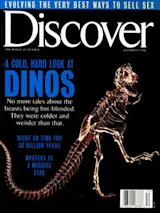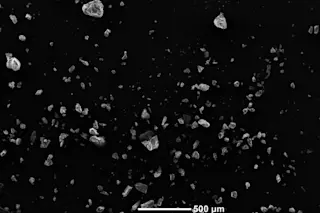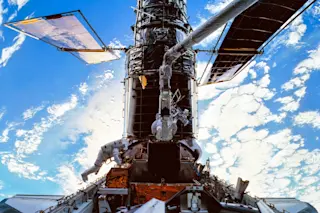The space shuttle seems like the last place you would experiment with fire. But for two weeks last July, astronauts aboard the space shuttle Columbia observed how tiny floating flame balls burned in sealed, gas- filled chambers. It wasn’t an esoteric exercise. Such small flames drive all internal combustion engines, and engineers might be able to improve on existing designs if they had more insight into how these flames form and burn.
When a spark plug ignites the mix of air and fuel inside an engine, the resulting minute fireball heats the air around it, which expands and pushes against a piston, providing the power that drives the vehicle. But such small flames are difficult to study on Earth. Hot, light gases sweep upward, carrying away energy; the flames extinguish too quickly to be carefully studied. On the space shuttle, however, gravity is only about one-millionth as strong as on Earth. Buoyant gases play essentially no role, and even the weakest flames burn steadily.
Automotive engineers have known for a long time that if you could burn a leaner fuel mixture in engines, you could get higher fuel efficiency and lower pollutant formation, says Paul Ronney, a combustion researcher at the University of Southern California who conceived and helped design the shuttle flame experiments. Because the chemical reaction rates involved in combustion are very sensitive to temperature, if you increase the temperature by 10 percent, the rate more than doubles--and the rate at which some pollutants form increases thirteenfold, particularly the oxides of nitrogen that make our skies brown.
But if the mix of fuel is too dilute, it will burn slowly and make an engine misfire. If the fuel in your engine doesn’t burn fast enough, it won’t get burned in time before the exhaust valve opens, says Ronney. You’ll just be dumping out unburned fuel. In the shuttle experiments, Ronney and other researchers hoped to take a careful look at how minimal amounts of fuel ignite and burn.
Shuttle astronauts mixed and ignited about six gallons of various gases: hydrogen, oxygen, and either nitrogen, carbon dioxide, or a heavy gas called sulfur hexafluoride in a sealed chamber. These mixes are used in the shuttle’s engines, and NASA is particularly interested in better understanding them.
The flames on the shuttle provided some surprises. In virtually all combustible mixes if you fire a spark at the center, you start out with an expanding sphere of flame that grows until it reaches the walls of the combustion chamber. Then it goes out because there is no more fuel, says Ronney. But the flame balls on the shuttle didn’t behave that way. Instead of getting an expanding sphere of flame, the initial flame ball quickly divides into several smaller balls, which gradually move away from each other, he says. It almost looks like a cellular organism that is growing and dividing.
Why do flames behave this way? Without gravity, they are not buoyant and can’t rush out to consume new fuel and oxygen, so they break up as they exhaust the fuel at their center. The flame balls shrink as they use up the fuel and then wink out, which can take more than eight minutes. It is the only example of a flame in which there is no convection, says Ronney. Instead fuel and oxygen diffuse into the flame ball, and the heat and combustion products diffuse out.
Because they are the simplest kind of fire, flame balls are an ideal subject for researchers trying to fine-tune combustion models. While several models of weak flames exist, none have yet been able to predict the actions of Ronney’s flame balls accurately. If the models can be changed to reproduce the shuttle experiments successfully, those same models could be used to reproduce the behavior of fuels in all kinds of engines. The idea is to identify which, if any, of these models will give us good predictions for weak flames, Ronney says, and then apply the models to flame balls as they would occur in engines. Then it’s up to the automotive designers to incorporate it into their designs of lean combustion engines.














